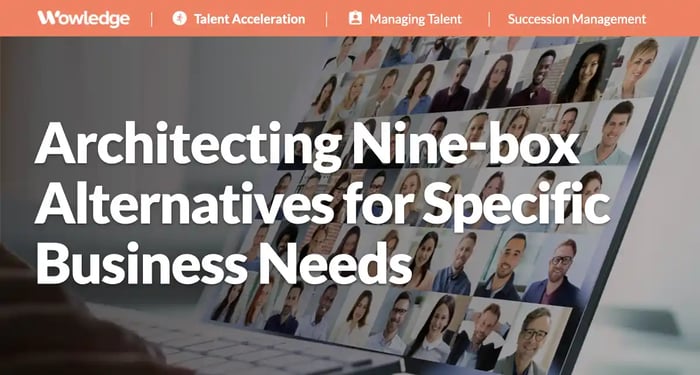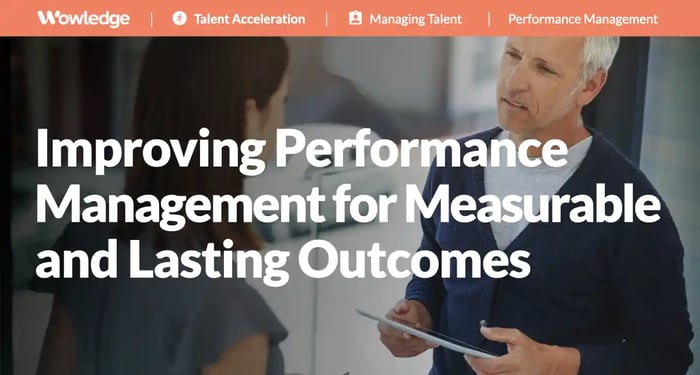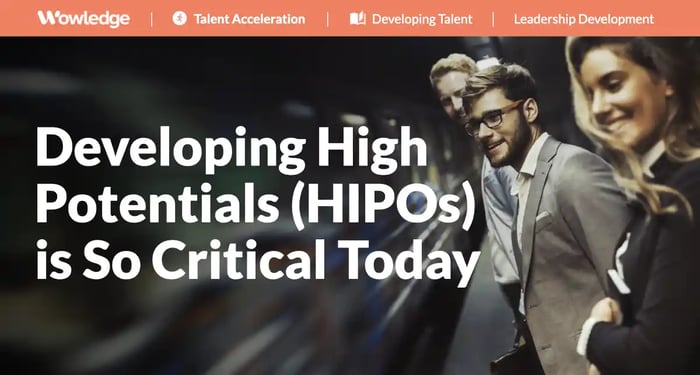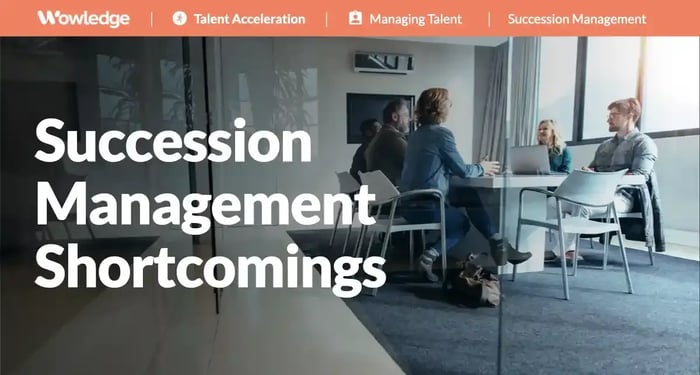Table of Contents
Talent assessment is a notoriously tricky and challenging evaluation of human capabilities, performance, contributions, and potential in the workplace. A range of HR processes and tactics aims to accomplish this by accurately evaluating and comparing employees in support of efforts to reward, recognize, compensate, and promote those who are most likely to drive future corporate success and growth. However, despite the best efforts of academics, consultants, HR leaders, and talent specialists, finding the most accurate and reliable way to accomplish this remains elusive. Among the methods used over the past five decades, comparing employees using a “nine-box” talent comparison matrix tool remains a dominant yet widely criticized approach. While the search for nine-box alternatives continues, many organizations need to update their talent ecosystems instead.
The nine-box model history and value proposition
The nine-box framework was developed by consultants at McKinsey & Company in the 1970s for General Electric as a means to categorize employees and enhance its talent management and development efforts. It was designed to differentiate employees and identify their relative value to the organization, based not only on their annual or ongoing performance, but also on their potential for growth and future contributions. It was intended to provide a broader view of the robustness of targeted pools of employees in terms of their positioning to replace their bosses or transition to new roles.
It has been primarily used in succession planning exercises to assess the health of the leadership talent pool and identify development needs. Increasingly, it is also used in talent reviews below senior management roles to identify high-potential employees and compare similarly situated, skilled, and level employees. The value proposition of this tool lies in its design as a comparative tool that summarizes and categorizes a group of employees, as well as its forward-looking nature as a talent planning method.
The goals and benefits of using a nine-box grid
Despite calls for finding nine-box alternatives, the tool and process, as designed, can offer value to organizations and their leaders. In particular, it standardizes the language, concepts, and methods for talent assessment that middle managers and senior-level leaders are most commonly familiar with. When used as an annual or ongoing effort, it familiarizes leaders with what top leadership and internal talent experts define as excellence and contribution, as well as what they expect to see from the workers in their respective functions and business units. The reasons for deploying the nine-box grid include:
- It is simple, widely accepted, and understood by senior managers.
- Captures in a summarized form an entire workforce segment on a single table.
- Enables visualization of talent pool gaps and shortcomings.
- Creates common terminology and shared definitions about the criteria that are used in performance evaluation, succession planning, promotion decisions, and development planning and activities.
When used in a group-based process (such as talent reviews or calibration sessions), it creates a series of highly desirable benefits, such as:
- Generates more observations for a more valid and shared assessment of individual talent and contributions.
- Supports healthy conversations on employees, their capabilities, and their relative value to the organization.
- Engages groups of leaders and creates an environment for better understanding talent outside of their sphere of influence.
- Challenges assumptions, reduces and manages biases, and spreads awareness and knowledge about targeted employees and their skills that can be deployed in other functions and locations.
- Raises talent assessment from an individual (managerial) exercise to one of a shared responsibility and ultimately, can increase the management team’s sense of ownership over all employees as “corporate assets.”
Issues with common applications of the nine-box tool
The reasons why many HR experts and influencers criticize its use are extensive, and start with the fact that the tool and its primary use cases have not changed much since their widespread adoption many years ago. The truth is that many organizations deploy it like a performance evaluation, with a continued reliance on a highly structured input by individual managers, a process of one-up managerial approval, followed by its inclusion as one of several steps in a succession or talent planning cycle. The drive of many to seek nine-box alternatives extends beyond that, with some significant challenges arising from how it is designed and implemented in many organizations. Among the challenges that are raised by many include arguments that when using the tool, it too often:
- Relies upon a single manager’s assessment as a starting point. The dependence of managers’ evaluations and recommendations introduces naturally occurring personal biases and preferences into the process. Too many employees who do not meet a manager’s preferred standards or have unseen aptitudes and true growth potential are left out of the process.
- Lacks clear, distinct, and understood criteria. There is a need for specific and detailed criteria to distinguish between high, moderate, and low performance and contributions across similar roles within an organization. A lack of quantified standards is one issue, and the absence of explicit statements on how to distinguish between proficiency levels in competency models leaves their rating open to individual interpretation among managers.
- Uses unclear definitions and measures of potential. Potential is essentially a guessing game, as making objective and understandable descriptions is difficult. Even with the use of validated (by I/O Psychologists), the potential for success in future roles can be impacted by many factors external to the individual’s control.
- Provides insufficient detail to drive action. The nine-box is, by design, a summary of the relative and comparative assessment of a group of individuals. It is designed for use in conjunction with performance evaluations, formal and observational assessments, individual development plans, and added criteria such as critical experiences, readiness, aptitudes, and learning agility.
- Looks backward. The tool relies on evaluations of the individual against often static competency models, job descriptions, and goal achievement, drawing insights and making projections about an individual’s potential. Many organizations overlook the importance of considering how future roles and their associated requirements will evolve, as well as the skills the organization will need in the years to come. For example, the upheaval in job requirements due to the adoption of AI and related technologies serves as a warning sign.
- Classifies employees in ways that can be lasting. Human beings and their life circumstances change, and the labels that a nine-box framework applies often do not. Any work-related system needs to be flexible and adaptable to changing professional and personal circumstances. Consider the degree of fit with a supervisor, the extent to which one’s skills are being fully exploited and leveraged in a given role, or how an employee’s circumstances (childbirth, illness, educational pursuits) can change or lessen their ability to contribute in the short to mid-term.
- Does not take personal aspirations or work content preferences into account. The evaluation of an individual’s potential can be directly impacted by the job, job family, or function in which they operate. Employees perform better and show more promise when they are in roles well-suited to their personality, interests, and strengths. When nine-boxes are used as an element in a broader succession or career management process, such factors can emerge, but in isolation, they fail to be recognized.
- Is not well-integrated with succession, performance, and development planning exercises. Placement in the matrix should be fed directly by data and insights from other talent management processes and documentation. Unfortunately, the input to the nine-box is often created separately by managers whose memories of their (multiple) employees’ experiences, successes, and contributions can be faded and limited. Despite well-intentioned and integrated HR systems, many organizations fail to provide the necessary data, trends, and insights that managers need to place people in each box of the matrix effectively.

Building nine-box alternatives
Start with a clear purpose and use cases
For most organizations, the question of how to improve or replace the classic nine-box model boils down to a simple question: “What are we using to compare people and for what purposes?” It is essential to articulate and obtain leadership agreement on how the insights from such an exercise and documentation will be utilized as the search for nine-box alternatives starts, as well as what business outcomes will be supported and improved.
The use in succession management for top roles is a board-level concern, and the extent to which an improved process can help achieve leadership continuity, stability, and some certainty through such plans makes it a top use case. A similarly powerful case can be made for using it in the assessment, identification, and management of high-potential (HiPo) or other employees in strategically critical roles (from a critical workforce segmentation exercise) who may be at risk for raiding by competitors or interested in new challenges.
Other potential use cases include:
- Talent calibration sessions
- Turnover risk assessments
- Stack ranking of employees’ total contributions
- Compensation decisions (e.g., merit increases, bonuses, stock)
- Promotions
- Development and mobility planning
Determine what should be assessed
Once the purpose for developing nine-box alternatives has been determined, moving beyond a performance X potential evaluation can become clearer. Consider what separates the most valued employees in any job, function, or level, and initiate a conversation with leaders about the differentiators. What many will say certainly relates to performance and potential, but listen closely to how they describe the elements of those. When leaders explain what outstanding performance means and how they admire workers who learn and respond successfully to new challenges, document these definitions for future use. For example, adaptability, motivation to learn and expand their skills, and achieving success in new or unique business challenges, environments, and roles are powerful evaluation criteria.
Those definitions help establish standards for comparing employees within a defined grouping (e.g., executives, HiPos, data scientists, enterprise sales consultants). The key is to create criteria that are specific, measurable, and observable.
Assessment categories to consider when seeking nine-box alternatives include criteria that can be used in a multi-criterion matrix that replaces the 3X3 grid, such as a 5X5 or 3X7, using better defined and more elements such as:
Performance
Measurement should examine performance over time (e.g., past three years), and whether it is trending upward, downward, or holding steady. A focus on measurable contributions and results should always be a priority wherever possible. Consider also how frequently employees are members of winning (highly successful) teams. While they might not stand out as individuals, their presence may be evidence of significant contributions made behind the scenes.
Potential
Defined as having a high likelihood of growth into, and future success in, more advanced roles. This should be based upon an observed exhibition of successful and rapid adaptability into new roles, functions, or organizations. Leadership potential can show up in group projects, company social (e.g., employee clubs, sports teams, or special interest group (SIG) contributions), or internal social or knowledge collaboration platforms. The growth potential is often a byproduct of those who exhibit high levels of learning agility, continuous learning behaviors, work innovation, and success in various roles and at different levels.
Core values demonstration
Highly valuable (and valued) workers separate themselves based upon the observable demonstration or role modeling of critical organizational values such as innovation, personal integrity, teamwork, and collaboration (e.g., through training, mentoring, and teammate ratings/reviews). Rating employees on these (with specific examples) in the performance management process often creates data that can be leveraged for employee value comparisons.
Cultural alignment
Similar to a core values assessment, considering each employee’s fit with the company culture involves evaluating their behavior, acceptance, and adoption of cultural norms and expectations, as well as their level of engagement over time. While caution should be exercised by those who overdo or self-promote on this front, as different perspectives drive innovation and positive cultural change, a solid attachment to core cultural elements can serve as a basis for positive evaluations.
Business priority results
Employees can be distinguished based on their contributions, regardless of their magnitude or significance. Consider the extent to which individuals propose, design, and push for innovations in product or service design, development, sales, and delivery that impact costs, sales, or customer outcomes. Even at the lowest levels of the organization, look for recommendations that improve process workflows, efficiencies, effectiveness, and reduce waste, as these have value.
Competency assessments
Well-defined and delineated competencies (leadership and functional) provide observable and agreed-upon models for comparing employees. As they lend themselves to comprehensive assessments, they need to clarify different levels of demonstrated proficiency (e.g., novice, skilled, expert, master), each with measurable or observable estimates of frequency of application (e.g., at times, frequently, often, consistently).
Readiness to move
When an individual has been in a role for more than three years, has consistently been assessed as “fully meets or above” for multiple years, expresses an interest in new roles, or is actively pursuing learning opportunities or paths outside their current role and function, they should be evaluated for new roles. People can stagnate in the same role with the same managers, peers, and customers (internal or external). If they possess valued expertise and contributions and meet or exceed other criteria, identifying them for reassignment, transfer, or promotion is an essential talent management practice.

Best practices when designing nine-box alternatives
The 3X3 matrix may be criticized as dated or overly simplistic, but it is not the matrix itself that is the problem. The fact is that the talent evaluation ecosystem requires review and updating to make these more effective. Some organizations are already adopting new approaches to make the nine-box more agile and actionable. The input (assessment data used) and process (how comparisons will be made and by whom) are as important as the output (the format and content of the matrix). To that end, building best practices into the criteria, methods, and processes that define and surround it will make nine-box alternatives more impactful.
Criteria
- Define the most valued and effective role capabilities and test against those. Do this for leadership and any other roles targeted by the process. Measure and analyze performance data to validate these on an ongoing basis.
- Clearly define each criterion and provide behavioral examples of what great, good, and sub-standard look like. Managers, raters, and reviewers need context. Further define those in terms of the frequency of demonstration of the skill or capability.
- Measure individual AND team performance. There is tremendous value in understanding who consistently contributes both as an individual and as part of high-performing teams. For succession and promotion decisions, collaborative behavior becomes an increasingly critical success factor in success at senior and executive roles.
- Include interpersonal capability assessments. Poor or below-standard interpersonal skills often derail success and potential. The measurement and development of emotional intelligence, active listening, and interpersonal communication can provide invaluable insights into an individual’s ability to rise through the ranks.
Methods
- Formal, validated assessments. Introduce more objective assessments of employee capability that add more certainty than human recommendations, observations, or judgment alone. Consider psychologist-created and validated tests of emotional intelligence, aptitude, cognitive reasoning, leadership potential, strengths, and other critical capabilities to establish a more reliable comparison.
- 360-degree assessment and feedback. Feedback and perspectives from bosses, peers, and subordinates offer powerful insights into employee behaviors, strengths, and weaknesses, whether as leaders or team members. It goes beyond the recommendations and views of a single manager by getting multiple perspectives from different relationship viewpoints using a structured set of critical behavior and decision-making criteria.
- Organizational Network Analysis (ONA). ONA utilizes a range of organizationally generated data, including emails, collaboration platforms, location data, and other sources, to identify individual interaction patterns. It identifies the extent to which individuals lead or participate in value-added interactions, impact, and influence within and across departmental, functional, and business unit lines and levels. It is an outstanding analysis to identify influencers, subject matter experts, innovators, and those driving collaboration and idea sharing.
- Assess the frequency, consistency, and reliability of demonstration of values, competencies, behaviors, contributions, and activities. Multiple examples of observed behaviors and capabilities are a necessary standard to establish the existence and proficiency level of a given skill in an individual. HR and business leaders should always press for details and examples of accomplishments and capabilities.
- Train managers to be better observers, data collectors, and talent assessors. Overcoming the observation that single manager recommendations are flawed, and influenced by (often unintentional) biases, formally educating and coaching line managers is essential. Contemporaneous documentation of observed or experienced behaviors should become a standard for every manager.
- Leverage new and emerging technology. Advanced technologies, such as skills assessments, talent marketplaces, and learning pathways (with embedded assessments), are increasingly AI-driven. These enable employee assessments and talent identification based on a wider, more objective set of data on performance, potential, skills overlap, engagement, and job families and experiences. Skills management platforms help organizations track, manage, and visualize skills data, identify gaps, and recommend new roles and personalized learning opportunities.
Process
- Integrate nine-box alternatives with HR and talent processes. Extracting the most value from the use of these assessment summary tools is often a challenge. Identify the use cases with the most potential for improving talent outcomes, and turn the grid placement results into action by integrating them into the succession, career planning, mobility, compensation, and development planning exercises and workflow outputs.
- Expand group talent calibration. Increase the use of talent calibration sessions to leverage the expertise of expert groups in presenting, evaluating, defending, questioning, and aligning on decisions regarding performance ratings, succession, promotions, rotations, transfers, and compensation actions. Require well-developed and data-supported examples and ask tough questions when facilitating discussions and comparing individuals’ goal difficulty, skill sets, capabilities, motivations, and business impact.
- Identify those who are on a hold pattern. Take a long view of employee performance, potential contributions, and organizational value. Examine performance and contribution trends, and consider an employee’s value despite short-term slowdowns or flattening. While personal, health, and family circumstances can impact employee value in the short term (and legal constraints exist regarding the use of those as considerations), those who are viewed as continuing to have potential and high value should be considered regularly for movement within the grid. Nine-box alternatives should be a living document that flexes just as people and their life circumstances and choices do.
Relevant Practices & Tools
Advanced Succession Management Practices that Create a Structured Approach to Identifying and Developing Future Leaders. >
Succession Management is a formalized and structured process that drives how executive and critical skill roles will be staffed and replenished... more »
Identifying and Calibrating Successors and HIPOs for Each Role Through Structured and Standardized Assessment Sessions. >
Naming potential successors for executive and critical roles is a collaboration between leaders that requires thought, preparation, and discussions... more »
Leveraging AI Technology for Automated Identification and Planning for More Equitably Developed Succession Pools. >
Newer succession management technology brings the promise of more simplified and objective decision making using integrated datasets and/or artificial intelligence (AI) and machine learning (ML)... more »
Calibrating Goals and Performance to Enhance Group Equity and Fairness of Performance Evaluations. >
Key elements to emerging performance management are the group comparison and alignment of employee goals and performance evaluations... more »
The Nine (9) Box Tool: Document and Facilitate Future Leader Identification and Discussing Actions in Succession Management Processes. >
A matrix designed for both use throughout and as a result of the future leader identification portions of the succession management process... more »
About Wowledge
Wowledge is the implementation-first platform designed for lean HR teams and consultants who need to design and scale strategic HR programs efficiently—without starting from scratch.
Our members gain access to continuously updated best practices, step-by-step guidance, expert-built tools, and customizable templates—all structured to accelerate the development and implementation of key HR programs.
Recognizing that every organization operates at different levels of sophistication, Wowledge’s scalable system of best practices follows a stage-based approach—Core, Advanced, and Emerging—ensuring HR professionals can implement solutions tailored to their organization’s unique needs and goals.
Your Shortcut to Amplifying HR Impact!
Get started for FREE! Learn more.










